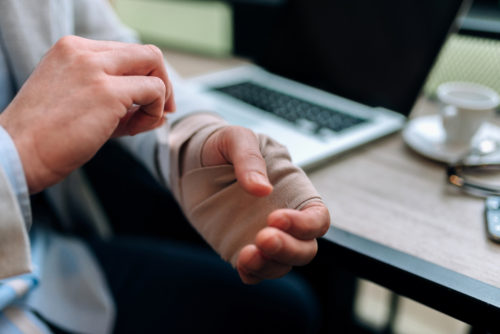Burns in the workplace are a substantial social and economic threat to individuals, families, and communities. Severe burn injuries often result in significant barriers to return to work that include contractures, amputations, weakness, and psychological issues such as body image concerns, depression, and posttraumatic stress. Our Chicago burn injury lawyers can help compensate you for your injuries and get your life back on track.
Despite ongoing safety measures and guidelines, burns in the workplace continue to account for a considerable percentage of all burns. Up to 30% of all serious burn injuries among adults occur at the workplace.
Workplace burns are serious; you don’t have to face the legal complexities alone. Contact us at (312) 766-1000 or email [email protected] for a free consultation with our dedicated attorneys. Your road to recovery starts here.
Burn Injury Statistics
Statistics presented by the Occupational Safety and Health Administration (OSHA) show that work-related fires and explosions account for more than 5,000 burn injuries annually in the US. Studies are showing a substantially high number of injuries occurring in the workplace, ranging from 10 to 45% of all burns. OSHA cited a study that showed 40% of all workplace burn deaths were related to explosions and burns.
The Food Service Industry experiences the highest number of burns of any employment sector, about 12,000 annually. Cooks, food handlers, kitchen workers, and wait staff are among the top 50 occupations at risk for on-the-job burn injury.
Workplace Safety Training
Workplace safety requires training and preparedness. A safe workplace starts with awareness and is maintained through the employer’s and all employees’ collective efforts. Examples include learning how to read technical specifications for machine use and understanding how to prevent potential injuries from burns. Sometimes, despite safety efforts, failed employer procedures, defective equipment, or another worker’s negligent actions can cause injuries to responsible employees.
These injuries can be the most painful and serious result of unsafe workplace practices or conditions. Flames, explosions, and electronic heating elements are common culprits in burn injuries, but chemical exposure can also cause burns.
Four Common types of burn injuries:
Chemical Burns
When employers fail to provide PPE (Personal Protective Equipment), employees are forced to handle dangerous chemicals necessary to complete their jobs without the benefit of gloves, face protection, and goggles. Chemical burns occur when corrosive chemicals contact the skin and cause scalding, which can burn several layers of skin. Industrial cleaners and laboratory chemicals with mislabeled bottles are common sources of these burns.
Electrical Burns
Workers who handle electricity near water can endure electrical burns by electrocution. Electrical currents that pass through water are powerful, and when human tissue interrupts the current, the skin’s surface layers are badly burned.
When high-voltage areas with exposed wires are not properly marked, workers may enter the dangerous area to perform duties and sustain these frightening injuries. Electrical burns are prime examples of corporate negligence in the manufacturing sector.
Thermal Burns
Hot liquids, exposure to open flames, and explosions can cause burning, similar to chemical burns. It is important to treat thermal burns immediately because second—to third-degree burns are possible from prolonged contact with the burning substance.
Other Burns
Several other types of workplace burns occur in certain conditions and environments:
- Cold burns are possible when workers are forced to work extended periods in extremely cold conditions such as freezers or are exposed to liquid nitrogen.
- Friction burns are commonly associated with road rash or forceful contact with hard surfaces that rub the skin until it burns.
- Radiation or sunburns can occur if workers are exposed to concentrated ultraviolet rays or forced to work outside under excessive sunlight for prolonged periods.
What to do After Experiencing a Workplace Burn Injury
Workers who endure workplace-related burns in any form should seek immediate treatment. After being treated, the injured worker must report the incident to a supervisor or the human resources department.
After reporting the incident, the injured employee would do well to have witnesses’ names and contact information, photos or videos of the scene, and photos of the injuries.
Injured workers receiving treatment are encouraged to keep track of hospital, medical treatments, therapy, and medication billings. Any bills that are not being paid, any income not being earned, and all other documentable losses should be recorded in some fashion to recover for these losses.
Filing a Workers’ Compensation Claim
Employees who suffer workplace burn injuries are entitled to receive benefits under the Workers’ Compensation Act. As these benefits are not automatically provided, workers must file a timely application to file the claim to initiate a review of the burn accident to determine if benefits are payable. Available benefits include ⅔ wages while disabled, medical expenses paid, and a lump sum for the permanency resulting from a personal injury.
In Illinois, unless an injury was self-inflicted, occurring during the commission of a crime, while off the clock, or while in violation of company policy, most persons injured at work should receive benefits.
Employers are required to carry insurance for employer injuries. Employer workers’ compensation insurance is mandatory. Furthermore, all employers must post eligibility information in an area viewable by all workers, like break rooms or outside main office areas. Employers are also responsible for reporting injuries that force employees to miss three or more consecutive work days to the Illinois Workers’ Compensation Commission (IWCC).
Injured employees are given 45 days to notify an employer that an incident occurred at work. Should the employer’s insurer decide benefits are not payable, workers who suffered burn injuries may wish to file their claim with the IWCC.
Getting Legal Help
If an employer or insurer denies workers’ compensation benefits, it is encouraged to consult with an experienced law firm to handle claims moving forward. Given the proof required to substantiate a worker’s claim of an on-the-job injury, employees may find getting a final approval more complicated than it is worth.
With an injury attorney’s help, burn victims can concentrate on their recovery. In contrast, the Workers’ Compensation attorneys handle the filings, appearances at the Worker’s Compensation Commission, medical bills and records collection, and all related proceedings. If a burn injury case is not settled by negotiation, it will proceed to an evidentiary arbitration hearing. An experienced and skilled workers’ compensation claim is necessary to secure your rights to fair compensation.
Chicago Burn Injury Attorney
If you or a loved one has sustained a workplace injury from a severe burn, we encourage you to contact the burn injury lawyers at the Blumenshine Law Group by phone or text at (312)766-1000, email us at [email protected], or fill out our contact form below for a free consultation.




